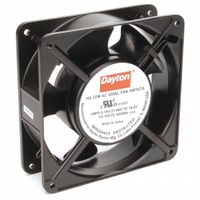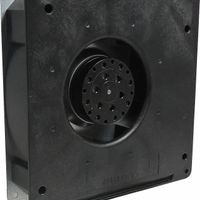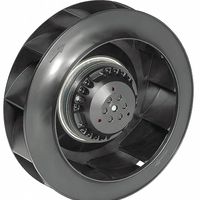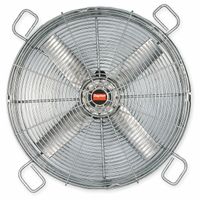Call +(254) 703 030 000 / 751 483 999 / 721 704 777
- Home
- Hvac And Refrigeration
- Cooling Fans
- Equipment Cooling Axial Fans
.....Read More
Frequently Asked Questions
What are the differences between axial fans and other types of cooling fans?
Axial fans and other types of cooling fans, such as centrifugal and crossflow fans, differ primarily in design, airflow direction, pressure capabilities, and applications.
Axial Fans:
- **Design**: Axial fans have blades that rotate around an axis, similar to a propeller. The airflow is parallel to the axis of rotation.
- **Airflow Direction**: They move air or gas along the axis of the fan, creating a flow that is parallel to the shaft.
- **Pressure Capabilities**: Axial fans are generally used for applications requiring high airflow rates at low pressure. They are not suitable for high-pressure applications.
- **Efficiency**: They are efficient for moving large volumes of air at low pressure, making them ideal for ventilation and cooling applications.
- **Applications**: Commonly used in HVAC systems, cooling towers, and electronic cooling due to their ability to move large volumes of air efficiently.
Centrifugal Fans:
- **Design**: Centrifugal fans have a different blade design, often resembling a squirrel cage. The air enters the fan wheel and is turned 90 degrees by the centrifugal force.
- **Airflow Direction**: The airflow is perpendicular to the axis of rotation.
- **Pressure Capabilities**: They can generate higher pressures than axial fans, making them suitable for applications requiring high pressure.
- **Efficiency**: More efficient in high-pressure applications but less efficient in moving large volumes of air compared to axial fans.
- **Applications**: Used in industrial processes, HVAC systems requiring high pressure, and dust collection systems.
Crossflow Fans:
- **Design**: Crossflow fans have a cylindrical shape with a long, narrow design, allowing air to flow through the fan twice.
- **Airflow Direction**: The airflow is perpendicular to the axis, similar to centrifugal fans, but the design allows for a uniform airflow across the length of the fan.
- **Pressure Capabilities**: They provide moderate pressure and are used where a uniform airflow is needed.
- **Applications**: Commonly used in air curtains, air conditioning units, and electronic cooling where space is limited.
How do I choose the right size of an equipment-cooling fan for my enclosure?
1. **Determine Heat Load**: Calculate the total heat generated by the components inside the enclosure. This is usually given in watts (W).
2. **Temperature Rise**: Decide the maximum allowable temperature rise inside the enclosure above the ambient temperature. This is the difference between the desired internal temperature and the external ambient temperature.
3. **Calculate Required Airflow**: Use the formula:
\[
\text{CFM} = \frac{\text{Watts} \times 3.16}{\Delta T}
\]
where CFM is cubic feet per minute, Watts is the total heat load, and \(\Delta T\) is the temperature rise in degrees Fahrenheit.
4. **Select Fan Type**: Choose between axial, centrifugal, or mixed-flow fans based on space constraints and airflow requirements. Axial fans are suitable for high airflow with low pressure, while centrifugal fans are better for high pressure with lower airflow.
5. **Consider Fan Size and Speed**: Larger fans can move more air at lower speeds, reducing noise. Check the fan’s performance curve to ensure it meets the required CFM at the necessary static pressure.
6. **Check for Environmental Factors**: Consider factors like dust, moisture, and corrosive environments. Choose fans with appropriate IP ratings or additional protective features if necessary.
7. **Noise Levels**: Ensure the fan’s noise level is acceptable for the application. Larger, slower fans are generally quieter.
8. **Redundancy and Reliability**: For critical applications, consider using multiple fans for redundancy. Check the fan’s MTBF (Mean Time Between Failures) for reliability.
9. **Power Supply**: Ensure the fan’s voltage and power requirements match the available power supply.
10. **Space Constraints**: Ensure the fan fits within the enclosure and allows for adequate airflow without obstruction.
What are the benefits of using an axial fan for cooling machinery?
Axial fans offer several benefits for cooling machinery:
1. **High Airflow Efficiency**: Axial fans are designed to move large volumes of air efficiently, making them ideal for cooling applications where high airflow is necessary to dissipate heat from machinery.
2. **Compact Design**: These fans have a simple and compact design, which allows them to be easily integrated into various machinery setups without requiring significant space.
3. **Cost-Effective**: Axial fans are generally less expensive to manufacture and maintain compared to other types of fans, making them a cost-effective solution for cooling needs.
4. **Energy Efficiency**: They consume less power while delivering high airflow, which can lead to reduced energy costs over time, especially in continuous operation settings.
5. **Versatility**: Axial fans can be used in a wide range of applications, from small electronic devices to large industrial machinery, due to their adaptable design and varying sizes.
6. **Low Noise Levels**: Many axial fans are designed to operate quietly, which is beneficial in environments where noise reduction is important, such as in office equipment or consumer electronics.
7. **Easy Installation and Maintenance**: Their straightforward design allows for easy installation and maintenance, reducing downtime and operational disruptions.
8. **Directional Airflow**: Axial fans provide a direct and focused airflow, which can be targeted to specific areas of machinery that require cooling, enhancing the overall cooling efficiency.
9. **Durability**: Made from robust materials, axial fans are durable and can withstand harsh operating conditions, ensuring long-term reliability.
10. **Customizability**: They can be customized in terms of blade design, size, and speed to meet specific cooling requirements, providing flexibility in various industrial applications.
How do I maintain and clean equipment-cooling fans to ensure optimal performance?
To maintain and clean equipment-cooling fans for optimal performance, follow these steps:
1. **Power Off and Unplug**: Always turn off and unplug the equipment before cleaning to ensure safety.
2. **Access the Fan**: Open the equipment casing carefully, following the manufacturer's instructions to access the fan.
3. **Inspect the Fan**: Check for dust, debris, and any signs of wear or damage. Ensure the fan blades are intact and the fan spins freely.
4. **Dust Removal**: Use a can of compressed air to blow away dust from the fan blades and surrounding areas. Hold the fan blades in place to prevent them from spinning while using compressed air.
5. **Deep Cleaning**: For stubborn dirt, use a soft brush or a microfiber cloth to gently wipe the fan blades and housing. Avoid using water or liquid cleaners.
6. **Lubrication**: If the fan is noisy or not spinning smoothly, apply a small amount of light machine oil to the fan's bearings, if accessible and recommended by the manufacturer.
7. **Reassemble**: Once cleaned, carefully reassemble the equipment, ensuring all parts are securely in place.
8. **Regular Maintenance**: Schedule regular cleaning every 3-6 months, or more frequently in dusty environments, to prevent dust buildup.
9. **Environment Control**: Keep the equipment in a clean, dust-free environment. Use air filters or dust covers if necessary.
10. **Monitor Performance**: Regularly check the fan's performance. If it becomes noisy or inefficient, consider replacing it.
By following these steps, you can ensure that your equipment-cooling fans operate efficiently, prolonging the life of your equipment and preventing overheating issues.
What are the common causes of failure in enclosure fans and how can they be prevented?
Common causes of failure in enclosure fans include:
1. **Dust and Debris Accumulation**: Dust can clog fan blades and obstruct airflow, leading to overheating and motor strain. Prevention involves regular cleaning and using filters to minimize dust ingress.
2. **Bearing Wear**: Bearings can wear out due to friction, leading to noise and reduced efficiency. Regular lubrication and using high-quality bearings can prevent premature wear.
3. **Electrical Issues**: Voltage spikes, short circuits, or poor connections can damage fan motors. Using surge protectors and ensuring proper electrical connections can mitigate these risks.
4. **Overheating**: Fans can overheat due to excessive load or poor ventilation. Ensuring adequate airflow and not exceeding the fan's rated capacity can prevent overheating.
5. **Vibration**: Imbalance in fan blades or loose mounting can cause vibrations, leading to mechanical failure. Regular inspection and balancing of fan blades, along with secure mounting, can reduce vibrations.
6. **Corrosion**: Exposure to moisture or corrosive environments can degrade fan components. Using corrosion-resistant materials and ensuring proper sealing can protect against corrosion.
7. **Mechanical Obstructions**: Foreign objects can obstruct fan blades, causing damage. Regular inspection and maintaining a clean environment can prevent obstructions.
8. **Aging and Wear**: Over time, components naturally degrade. Implementing a regular maintenance schedule and replacing parts as needed can extend fan life.
Preventive measures include regular maintenance, proper installation, environmental control, and using high-quality components. Implementing these strategies can significantly reduce the likelihood of fan failure.
How do I install an axial fan in an equipment enclosure?
1. **Select the Fan**: Choose an axial fan that matches the size and airflow requirements of your equipment enclosure.
2. **Gather Tools and Materials**: You will need a drill, screws, screwdriver, wire connectors, wire strippers, and possibly a jigsaw or hole saw.
3. **Determine Placement**: Identify the optimal location for the fan, typically near the top for exhaust or bottom for intake, ensuring it aligns with airflow needs.
4. **Mark the Cutout**: Use the fan's template or measure the fan's dimensions to mark the cutout area on the enclosure.
5. **Cut the Opening**: Use a jigsaw or hole saw to cut the marked area. Ensure the cut is smooth to avoid sharp edges that could damage the fan or wires.
6. **Install the Fan**: Position the fan in the cutout. Secure it using screws, ensuring it is tightly fastened to prevent vibration.
7. **Wire the Fan**: Strip the fan wires and connect them to the power source using wire connectors. Ensure the connections are secure and insulated.
8. **Test the Fan**: Power on the equipment to test the fan. Check for proper operation and airflow direction.
9. **Seal and Secure**: Use gaskets or sealant around the fan to prevent air leaks and ensure efficient airflow.
10. **Install a Grill or Filter**: Attach a protective grill or filter over the fan to prevent debris from entering and to protect the fan blades.
11. **Final Check**: Ensure all connections are secure, and the fan operates quietly and efficiently. Adjust as necessary.
12. **Close the Enclosure**: Once satisfied with the installation, close the enclosure and monitor the fan's performance during operation.
What are the noise levels associated with different types of equipment-cooling fans?
Noise levels of equipment-cooling fans vary based on design, size, speed, and application. Here are typical noise levels for different types:
1. **Axial Fans**: Common in computers and HVAC systems, they produce noise levels ranging from 20 to 50 decibels (dB). Smaller fans tend to be quieter, while larger, high-speed models can be louder.
2. **Centrifugal Fans**: Used in industrial applications, these fans can generate noise levels between 50 to 70 dB. The noise is often due to the higher pressure and airflow they produce.
3. **Blowers**: Found in applications requiring high pressure, such as furnaces, blowers can produce noise levels from 60 to 80 dB. The noise is typically a result of the high-speed rotation and air turbulence.
4. **Crossflow Fans**: Used in air conditioners and some electronics, they generally operate at 40 to 60 dB. Their design allows for quieter operation compared to other fan types.
5. **Mixed Flow Fans**: Combining features of axial and centrifugal fans, these are used in situations requiring both high airflow and pressure, with noise levels around 50 to 70 dB.
6. **EC Fans (Electronically Commutated)**: Known for energy efficiency and quieter operation, EC fans typically produce noise levels between 30 to 60 dB, depending on size and speed.
7. **Server Fans**: In data centers, server fans can be quite loud, often reaching 70 to 80 dB due to high-speed operation necessary for cooling dense electronic components.
8. **Laptop Fans**: Generally quieter, operating at 20 to 40 dB, but can become louder under heavy processing loads.
9. **Industrial Cooling Fans**: Used in large-scale applications, these can exceed 80 dB, requiring noise control measures.
Noise levels can be influenced by factors such as fan blade design, housing, and mounting, as well as the environment in which the fan operates.




